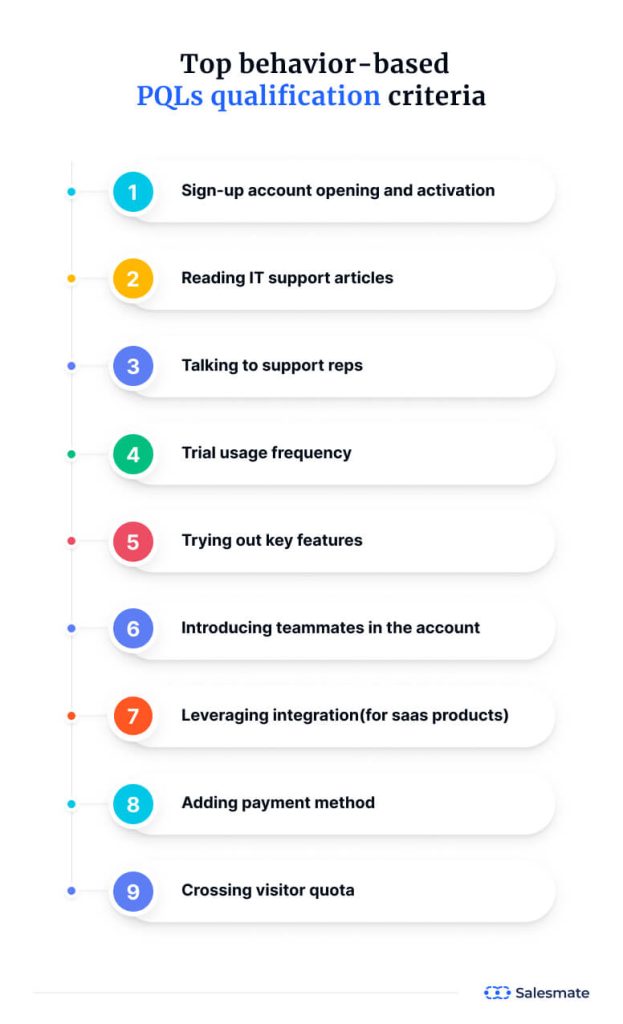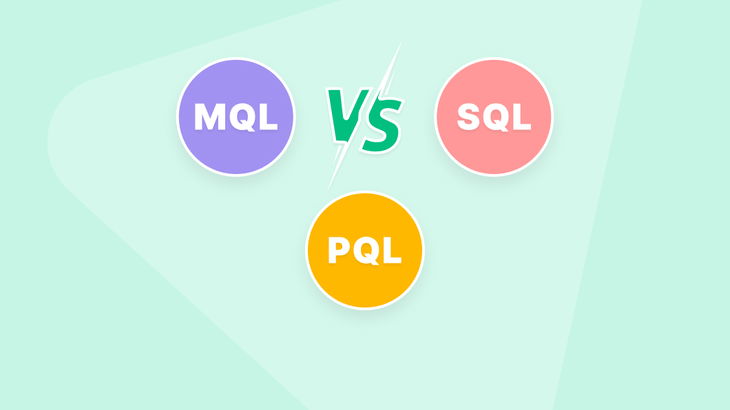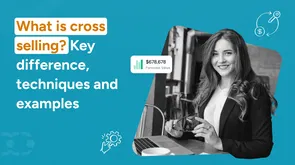21% of salespeople and marketers are unsatisfied with their current lead qualification process.
Maybe we need to understand the qualification process truly from the core.
There are three big qualification stages as per teams - MQL, SQL, and PQL (They all have different qualifying grounds).
This blog covers the main differences between MQLs, PQLs, and SQLs also how you can minimize your sales and marketing efforts with automation.
What is a marketing qualified lead?
Marketing qualified leads (MQLs) are potential prospects that have interacted with your brand's marketing activities somewhere at some point.
Such interactions reflect their interest in your product/services.
For example, you are a SaaS-based company, and a few web visitors sign up for your product webinar on your website. Then, these are marketing-qualified leads for you.
There are various factors based on which marketing teams create personas to define their ideal customer profile. These factors may include age, gender, demographics, etc.
Apart from this, MQLs are qualified based on engagement activities such as Live Chat/chatbot interaction on the website, web page visits, Web Form sign up for free downloadable resources, etc.
The top behavioral attributes to create a qualification strategy for MQLs are:
What is a product qualified lead?
Product qualified leads (PQLs) are those prospects who've experienced your product's functioning with a freemium service.
This is the stage where your prospects are in the moment to begin understanding your product/services from its functioning ability.
Also, they are at the stage to provide you with valuable feedback to improve the product in terms of user experience or anything more.
For a lead to be a PQL, it must have used the product in real, so if a lead has just signed up for a free trial or enrolled for a freemium service, it wouldn't be considered PQL.
PQL is a qualification stage for B2B companies that work on the freemium model.
Their purchase intent is purely based on how well your product has proven as a solution to them.
Every company has its criteria for PQL that mainly decide at which stage of the buying cycle lead will fall.
Below are some behavioral attributes to create a PQL qualification strategy.

What is a sales qualified lead?
A sales qualified lead is a potential customer that has moved from MQL to sales accepted lead and is now interested in a sales conversation to make a purchase.
Sales qualified leads (SQLs) are highly interested in the purchase, express ample interest through their response, and are willing to listen to discuss the budgeting, benefits, and more.
Every company has its qualifying criteria, but a lead to be an SQL must have shown enough intent to buy your product/services.
Typically, SQLs are progressed from MQLs or PQLs (in the case of B2B).
MQL Vs SQL Vs PQL: How do they differ?
Below table will help you get deeper insights into MQL vs SQL, PQL vs MQL and PQL vs SQL.
It will give you a clear picture of each lead's stage of the customer's journey, intent, and extent of interest in becoming a paying customer.
| Parameters | MQLs | PQLs | SQLs |
| When are they tagged? | MQLs are tagged when they consume your brand’s marketing content resource. | PQLs are tagged when they become unpaid users of your brand’s product/services. | SQLs are tagged when they express a deep interest in getting into a deal-closing conversation. |
| What is their level of interest? | Open to the idea of sales | Open to knowing the value proposition | Open for the sales pitch and deal closing |
| Are they engaged in marketing activities? | Engaged | Little | No |
| Are they using your product/services? | No | Fully | Showed interest in the direction |
| To whom with they communicate with? | Marketing people | IT support and salespeople | Salespeople |
| At which stage of the customer journey do they lie? | Awareness | Consideration and Decision | Decision |
From MQL to PQL to SQL: Lead qualification flow in one go!
To understand the flow of MQLs, SQLs, and PQLs, let's look at a typical funnel in B2B space.
See the visual representation of the lead qualification flow of MQLs, SQLs, and PQLs.







Key Takeaways
21% of salespeople and marketers are unsatisfied with their current lead qualification process.
Maybe we need to understand the qualification process truly from the core.
There are three big qualification stages as per teams - MQL, SQL, and PQL (They all have different qualifying grounds).
This blog covers the main differences between MQLs, PQLs, and SQLs also how you can minimize your sales and marketing efforts with automation.
What is a marketing qualified lead?
Marketing qualified leads (MQLs) are potential prospects that have interacted with your brand's marketing activities somewhere at some point.
Such interactions reflect their interest in your product/services.
For example, you are a SaaS-based company, and a few web visitors sign up for your product webinar on your website. Then, these are marketing-qualified leads for you.
There are various factors based on which marketing teams create personas to define their ideal customer profile. These factors may include age, gender, demographics, etc.
Apart from this, MQLs are qualified based on engagement activities such as Live Chat/chatbot interaction on the website, web page visits, Web Form sign up for free downloadable resources, etc.
The top behavioral attributes to create a qualification strategy for MQLs are:
What is a product qualified lead?
Product qualified leads (PQLs) are those prospects who've experienced your product's functioning with a freemium service.
This is the stage where your prospects are in the moment to begin understanding your product/services from its functioning ability.
Also, they are at the stage to provide you with valuable feedback to improve the product in terms of user experience or anything more.
For a lead to be a PQL, it must have used the product in real, so if a lead has just signed up for a free trial or enrolled for a freemium service, it wouldn't be considered PQL.
PQL is a qualification stage for B2B companies that work on the freemium model.
Their purchase intent is purely based on how well your product has proven as a solution to them.
Every company has its criteria for PQL that mainly decide at which stage of the buying cycle lead will fall.
Below are some behavioral attributes to create a PQL qualification strategy.
What is a sales qualified lead?
A sales qualified lead is a potential customer that has moved from MQL to sales accepted lead and is now interested in a sales conversation to make a purchase.
Sales qualified leads (SQLs) are highly interested in the purchase, express ample interest through their response, and are willing to listen to discuss the budgeting, benefits, and more.
Every company has its qualifying criteria, but a lead to be an SQL must have shown enough intent to buy your product/services.
Typically, SQLs are progressed from MQLs or PQLs (in the case of B2B).
MQL Vs SQL Vs PQL: How do they differ?
Below table will help you get deeper insights into MQL vs SQL, PQL vs MQL and PQL vs SQL.
It will give you a clear picture of each lead's stage of the customer's journey, intent, and extent of interest in becoming a paying customer.
From MQL to PQL to SQL: Lead qualification flow in one go!
To understand the flow of MQLs, SQLs, and PQLs, let's look at a typical funnel in B2B space.
See the visual representation of the lead qualification flow of MQLs, SQLs, and PQLs.
Visitors come to your website through various inbound lead generation and marketing efforts (ads, social media, content, etc.).
At this very first stage, they will start showing interest in your brand with engagement activities like checking out your website, blogs, and video content, downloading resources, attending webinars, etc.
Those who meet the set-up lead qualifying criteria for MQLs are considered suitable to go with nurturing.
Those who don't meet the criteria are considered not useful or unqualified leads.
MQLs are further nurtured. This lead nurturing helps to know more about your customers for better sales targeting.
Salespeople will start interacting and try to qualify these leads with various qualifying questions further.
So, with every positive response to the qualification questions, these sales accepted leads progressed to SQLs or unqualified leads.
Moreover, your reps need to engage with these SQLs to convince them to purchase or take the product trial for free.
Sales qualification is a key step to creating opportunities, and the best way to do it is by following a qualification framework!
Some MQLs become well aware of your product/services through your aggressive marketing.
So, they sign up for a free trial and ultimately become users.
So, once a lead start using your product/services, they fall into a PQL list.
Often, most PQLs get converted into paying customers themselves.
Can you automate the lead qualification?
Yes, you can automate your lead qualification process for MQLs and PQLs.
But SQLs mostly communicate verbally with the sales reps, so we cannot set any qualification criteria.
See the table to check on what grounds we qualify MQLs.
Based on behaviour
Leads qualify based on their engagement and profile fit. So, once a lead meets the lead score threshold, it will automatically qualify.
Then, your marketing team sends it to the sales team to further qualify with multiple efforts (sales calls, text, and email sequences).
See the step-by-step learning here:
With a lead scoring tool, you can set your qualification of leads as MQLs on auto-pilot.
For instance, you can automatically qualify leads based on their email engagement; you can set up email activity triggers (clicked, opened, response, etc.) and assign scores for each condition so that your software automatically takes actions and assigns scores to the lead to qualify.
Better understand with the visual below:
Like above, you can set various triggers and conditions for lead scoring actions to qualify leads for your sales team based on what your business demands.
Automated lead scoring becomes more effective with the support of a CRM, as you can streamline your marketing and sales team efforts from one centralized platform.
How about a CRM + automation platform that serves...
So, looking for a one-stop solution to manage and automate your business tasks is wise.
No Manual Pain, Auto-pilot you lead qualification Game!
With Salesmate, qualify high quality leads automatically for your sales team.
Bottomline: MQL vs SQL vs PQL
Leads express their intent differently at each stage throughout a customer's journey.
As we studied in the blog;
And to better understand these stages, study the various comparison like MQL vs SQL, PQL vs SQL or completely like MQL vs SQL vs PQL.
Understanding of quality of leads will move your business in the right direction.
Typically for a B2B company, making a qualification strategy for MQLs, PQLs, and SQLs will shorten their buying cycle.
For a better sales process, sales and marketing teams must sit together to understand their lead behavior and buyer's journey.
Moreover, marketing and sales teams both need to understand the flow of leads from the sales funnel for an efficient sales process.
And to ease your marketing and sales efforts, look for a unified customer platform that helps to facilitate your day-to-day tasks easily.
Frequently asked questions
1. What is the difference between MQLs and SQLs?
MQLs and SQLs differ in their intent. For example, a marketing qualified lead is curious about your product/services, whereas a sales qualified lead is more willing to purchase them.
2. What is SQL vs PQL?
Sales qualified leads are those prospects to whom you can sell your product/services, whereas PQLs express their purchasing intent based on product/service usage. Both SQLs and PQLs show their buying intent.
3. What is PQL vs MQL?
PQLs and MQLs show interest in your product/services on different bases. For example, PQLs express interest in usage-based, whereas MQLs express interest in feature-based.
4. Who converts PQLs into paying customers?
The conversion of PQLs is a collaborative effort of your marketing and sales teams. Firstly, the marketing teams aimed to attract visitors to sign up and use the product/services to become PQLs. Then, your sales teams will facilitate PQLs to upgrade their free plan and become paying users.
Sonali Negi
Content WriterSonali is a writer born out of her utmost passion for writing. She is working with a passionate team of content creators at Salesmate. She enjoys learning about new ideas in marketing and sales. She is an optimistic girl and endeavors to bring the best out of every situation. In her free time, she loves to introspect and observe people.